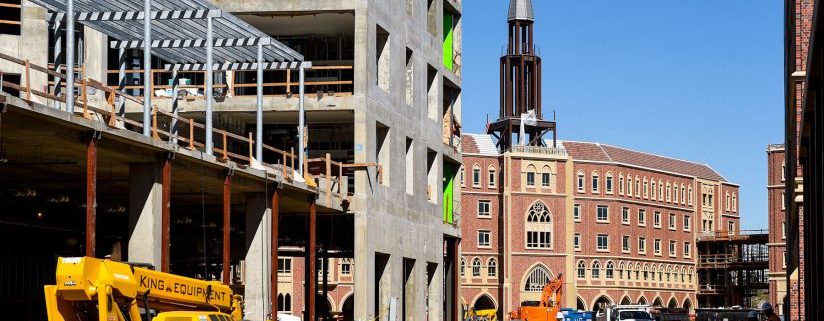USC Village installs rainwater containment system
The USC Village will now feature an underground rainwater containment system used to capture and filter almost all rainwater that falls above the Village. The system will become the largest privately owned structure of its type in Los Angeles.
The complex uses six wells that have been positioned under the 15-acre property. Each tank extends 60 feet below the ground and has the capacity to collect 200,000 gallons of water.
The water will first enter pipes situated above ground. These tubes permit water to flow into dry wells, which also act as filtration systems.
In the first 40 feet of these wells, rocks will help separate the trash and other contaminants, such as oil, that enter the pipes from above ground. The filtration system will then set apart any of the leftover trash from the rainwater.
“Basically the top 40 feet is where we collect all the drainage that comes in from the site,” said Willy Marsh, the project director of the USC Village.
After the water is filtered, it will flow into underground lakes referred to as aquifers. The water will ultimately be stored in these filtered wells. The purpose of the rainwater containment system is to recapture the stormwater before it enters the Los Angeles River or the ocean, thereby contributing to USC’s goal of conserving water.
“Water conservation at the new Village is an important lesson beyond the lecture hall,” said Vishnu Ratnam, an engineering graduate student. “It’s a good example to look at how you can put what you’ve learned to good use.”
Despite the large size of the system, administrators say that the project will not affect students.
“This will not affect student life in the USC Village,” said Emily Sandoval, the director for Residential Education. “Students will not even know it is there, as it will be built completely underground.”
Students look forward to the system’s sustainable practices.
“For next year, I am very excited to be living in a facility that cares so much about sustainability,” said Isabella Drake, a freshman majoring in theatre. “Not every living complex is as scrupulous about the environment as the Village plans to be.”
USC Housing residences currently feature 71 water bottle filling hydration stations that reduce the amount of plastic bottles used by USC students, and students are encouraged to recycle their trash in the recycling bins provided.
“Posters around the residence halls remind me to recycle my garbage,” said Danielle Hazime, a freshman majoring in human biology and a staff writer for the Daily Trojan. “The accessibility of the recycling bins around the dorms facilitates this responsibility.”
The USC Village will begin to house Trojans in Fall 2017. The complex will be able to house over 2,500 undergraduate students and will possess amenities that will integrate housing with dining, recreational and educational services.

